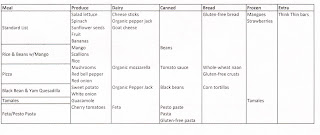This past Saturday was a particularly busy day. Henry woke up at 7:15 and immediately wanted to read books (three of them). Then we trekked to the grocery store to pick up supplies for cookie-making. When we returned, Matt woke up and the three of us made cookies for an Easter party we were going to that afternoon.
Then Matt, Henry, and Hoss went to the dog park while I went to my prenatal yoga class and visited a house with goats as part of the Austin Funky Chicken Coop Tour. Meanwhile, the boys went for a haircut. Upon returning home, Matt, Henry, and I went over to our neighbors' house. Henry enjoyed jumping on the trampoline.
Henry, Hoss, and I napped while Matt played in a soccer game. Then we reconnected and went to an Easter party, full of egg hunts, eating, playing with sticks, and bubble-making.
And then we trekked all the way to the IKEA (it's pretty far beyond the Austin city limits). On the way home, Henry started to melt-down. He was whining and crying and acting generally irritable (even though it wasn't his typical bedtime yet).
That's when it hit me: We crammed too much into the day. Duh!
Henry's tempermant is a gauge that let's us know how much his absorbent mind can handle. After the Easter party, we should have gone home for a quiet dinner and bedtime routine at home.
Of course children are adaptable. They can do everything we do if we make them. But if we pay close attention, they give us clues about their needs. Yes, they need stimulation, but they also need quiet, slow time to process that stimulation.
I find that if I try to cram too much in, I end up rushing Henry. As a toddler, he likes to take his time. He doesn't want to rush to the car to get to the grocery store in the most efficient way possible; he prefers to take his time, observing the moth on the screen of the front door and stopping to pick up a rolly polly. Everything in his very being is telling him to take it slowly, to explore the world around him, to take it all in.
I try to honor Henry's developmental needs at each stage as much I as can. Of course it means that I don't always get to check off the items on my to-do list. Heck, I try not to put any items on my to-do list every afternoon between picking up Henry from school and the time we start making dinner. I try to follow Henry's lead. We take our time using the toilet so Henry can pull down his own pants and underwear, pee, and then pull everything all the way up. I even sit down for the hand-washing process because it takes a while for him to climb the stool, turn on the water, wet his hands, turn off the water, get one squirt of soap, rub his hands together to make bubbles, turn the water back on, rinse off his hands, turn the water off, dry his hands, and then climb down.
Then we go through the slow processes of making snack together, sitting down to eat, and cleaning up.
Afterwards, we usually trek to the park for an hour, and I follow Henry's lead. Sometimes he wants to explore the periphery of the park, looking at the city's lawnmowers or climbing the turnstile at the city pool (which is closed until summer). Other days he wants to swing for a really long time. Sometimes he wants to play in the rocks, and othertimes he wants to ride his back.
When I follow Henry's lead as much as I can, I find that he is happier and exudes general contentment. He is more willing to comply with my demands when his needs are met. When he starts to throw tantrums or melt-down, it's usually because he is tired or overstimulated.
I'm not suggesting that we completely sacrifice our own goals or agendas for those of our children. I believe that our families are systems and that each component of the system has to compromise in order to help the larger system function well.
The over-stimulating Saturday was a reminder for me, however, that children have different developmental needs and tolerances at different ages. I want to pay close attention to Henry's developmental needs and adjust our life/schedule as much as possible to support him as he integrates his personality.
I imagine this process of observing a child's needs and responding accordingly will get even trickier when we add a new baby into the mix. Although it's a little daunting to think about, I look forward to undertaking such a worthwhile challenge.






























